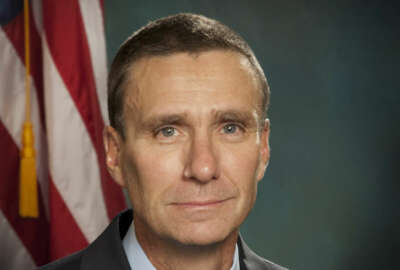
Sammies finalist led fight against last summer’s vaping death crisis
Health authorities were perplexed by a wave of sicknesses related to vaping. The CDC found the cause of the problem thanks to the Office of Medicine and Science.
Best listening experience is on Chrome, Firefox or Safari. Subscribe to Federal Drive’s daily audio interviews on Apple Podcasts or PodcastOne.
Last summer, health authorities were perplexed by a wave of sickness and death related to vaping. A concentrated effort by the Centers for Disease Control and Prevention eventually found the cause of the problem. It required almost a military degree of coordination among hundreds of CDC employees and health officials at the state level. It all worked, and the credit goes to the director of the Office of Medicine and Science at CDC. A finalist in this year’s Service to America Medals program, Dr. Peter Briss joined Federal Drive with Tom Temin.
Interview transcript:
Tom Temin: Tell us what it was like when these reports started to come in and you realized that they were jelling into what could be a potentially huge national health problem.
Dr. Peter Briss: In early August, health departments in Wisconsin and Illinois reported their first cases of a brand new syndrome. So all of the affected people had been using e-cigarette or vaping products. They reported symptoms like cough or shortness of breath or chest pain. They developed symptoms over a few days or over weeks and tests for infectious causes were negative. So clinical teams and health departments were a little baffled. And they had a lot of questions like, what are the characteristics of the syndrome? And how widespread is it? And most importantly, what caused it?
Tom Temin: And are there triggers in CDC where a certain number of events or a number of locations or whatever the case might be, suddenly light up and you say, golly, this is a more than localized issue?
Dr. Peter Briss: In response to this kind of problem, we at CDC have what’s what’s called the Graduated Response Framework. And so we start out generally in a program, in this investigation, it started out in our Injury Center and if things get bigger and more complicated, we can draw in more resources from other parts of CDC. We started a multi-state investigation by August 14, and we activated our Emergency Operation Center also in August.
Tom Temin: When the Emergency Operations Center begins operations, who is in there? How do you decide which parts of CDC should task people to that particular event?
Dr. Peter Briss: Again, responses generally start in programs that are most directly related to what the problem is. And so in this investigation, the Injury Center was very involved early because they direct much of our substance use work at CDC. The Office on Smoking and Health was very involved early because they’re they’re most involved with e-cigarette use and vaping.
Tom Temin: Uou did know fairly early without knowing the specific cause that somehow had relationship to vaping though?
Dr. Peter Briss: Exactly right.
Tom Temin: And how many people eventually were on this case from just CDC? We’ll get to the outer world after this.
Dr. Peter Briss: Eventually, about 400 people at CDC work directly on the rest response in some capacity. And in addition to that, in a big response, when that many people volunteer to work on a response, their regular work doesn’t go away. I usually say that that in a big response at CDC, everybody contributes either directly as part of the response or indirectly helping to do important work the responders what otherwise you do,
Tom Temin: What are the disciplines the 400 people brought in general terms?
Dr. Peter Briss: So epidemiologists had a big role in things like defining the scope of the outbreak, which eventually grew to involve all 50 states and the District. Laboratory scientists were very involved to try to figure out what was in these vaping products and later which of those substances might be in people. Communications is always a very big part of responses about trying to let the public know what’s known, when it’s known, and medical folks to give advice to healthcare systems and providers. Those are many of the disciplines that were involved.
Tom Temin: By the way, through all of this, you are an M.D., of course, at some level where you’re saying to yourself, why in the heck does anybody smoke these flavored weird things, suck that into their lungs?
Dr. Peter Briss: It does cross your mind.
Tom Temin: Your citation mentions the coordination with 50 state authorities. And that must get to really be kind of like a flea circus because you don’t want to overlap duties and everyone has different angles on the whole problem. How did that all work?
Dr. Peter Briss: This is American federalism, right. And so in a nationwide response, all of the states are involved. As our federal actors like CDC and the Food and Drug Administration, and a big part of the effort was coordinating all of those work streams and trying to get us all pulling in the same direction.
Tom Temin: I imagine a big problem would be simply duplication of effort, and then slightly variant conclusions, which could confuse things. Did you have people that are just dedicated to making sure nobody is duplicating and going over the same ground more than once?
Dr. Peter Briss: Yeah, there was an enormous amount of work to coordinate all of the people that were trying to solve this problem and I’m very proud of the fact that over about a six month period, all of us working together could identify a new problem, define it, ascertain that this was a nationwide problem, find the primary bad actor and communicate to people that were selling these products and to people who might be using these products in a way that mostly stopped the outbreak.
Tom Temin: Sure. And I guess in coordinating all of this and making sure it kept moving along, I don’t know what your specific M.D. specialty is, but sounds like you needed a lot of psychiatry to keep the feathers ruffled.
Dr. Peter Briss: So my initial training was in primary care, so I trained in internal medicine, pediatrics and later in preventive medicine and epidemiology. So a lot of medical practice is brief psychotherapy and that came in useful in this outbreak
Tom Temin: How cooperative was industry because, I think if I recall correctly, the legitimately regulated or controlled products by companies that have an interest in having clean products weren’t necessarily the culprits so much as adulterated materials coming in from foreign countries where no one knew the real origin or chain of custody of them.
Dr. Peter Briss: The primary implicated substances in this outbreak were THC containing products. that’s the active ingredient in marijuana. They were mostly through the illicit market and obtained through informal channels.
Tom Temin: Just a quick question, while this was going on, at some point, these types of questions move up to the political level, to the White House level, to congressional level — was that a set of mosquitoes you had to also kind of soothe and take care of?
Dr. Peter Briss: For the record, I’m not going to call any of those people mosquitoes. And there were at least in the course of this response, there were at least four congressional hearings and multiple briefings of Congress and congressional staffs, as well as a lot of communicating up through the executive branch. So there was a great deal, just as there was a great deal of coordination with the states, there was a great deal of coordination within the federal government.
Read more about their work here.
Copyright © 2025 Federal News Network. All rights reserved. This website is not intended for users located within the European Economic Area.
Tom Temin is host of the Federal Drive and has been providing insight on federal technology and management issues for more than 30 years.
Follow @tteminWFED





